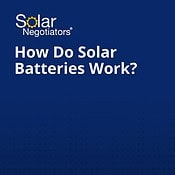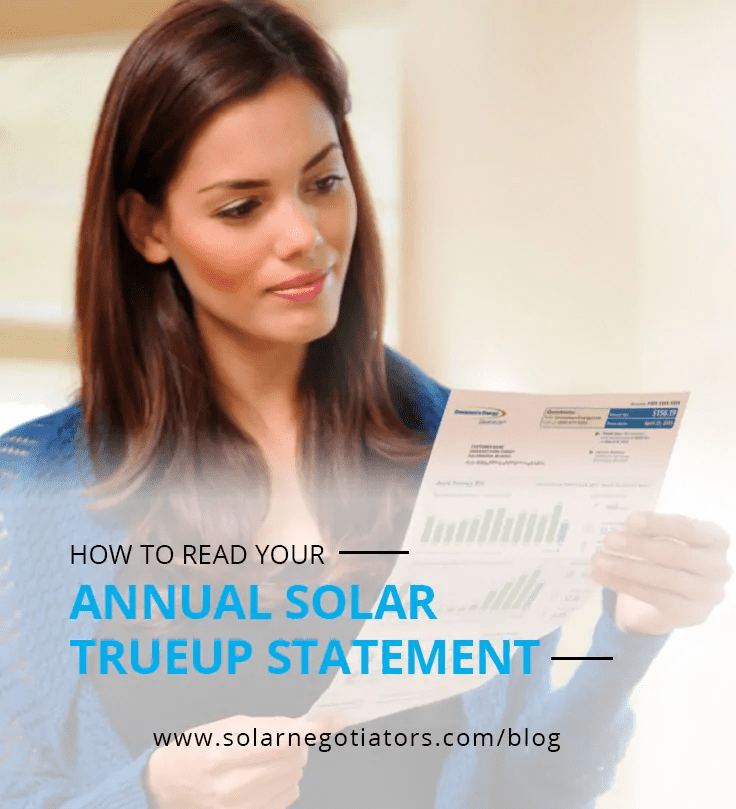
Understanding your Solar True-Up Bill
Net Energy Metering (NEM) is an important component in the rise of solar system installations. It allows owners of residential and commercial solar systems to facilitate and monitor their energy production. Over the course of 12 months, the solar customer will only pay for the total energy pulled from the electric grid. If their system ends up generating more power than they use, they receive a credit from PG&E. Each of these customers receives both an annual statement and a monthly bill stating their total power usage, this statement is also known as the true-up bill.
What is a true-up bill?
A true-up bill is a statement that is sent to you from your utility company at the end of your solar billing cycle, typically every 12 months. You can prepare for your yearly true-up statement by reviewing your monthly anticipated true-up charges, typically provided by utility companies.
Understanding How it Works
Your electric meter is “bidirectional”. This means, your electric meter will run backward as it measures the energy you produce from your solar system. It also will run forward each time you pull electricity from the grid. PG&E will take your “net” energy difference and either add a credit to your account or bill you for using more energy than you produced. As stated earlier, you will receive an annual and a monthly bill statement. It is important to know how to read both so that you know if you’ve accrued any charges you weren’t expecting. Monitoring your system on a regular basis allows you to catch any irregularities and avoid costly repairs or expenses.
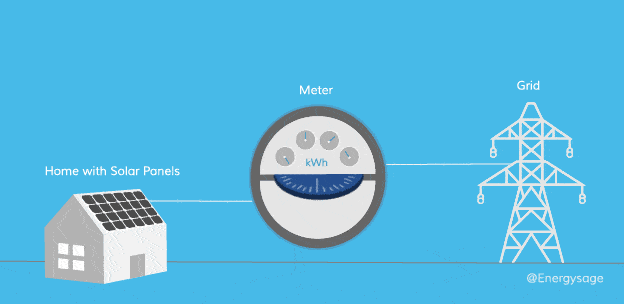
Your Billing Statements
The first page of your monthly energy bill displays a snapshot of your bill at the top under “Account Summary”. This section serves as an overview of total monthly electric and gas usage. It states the total energy charges due to date. Just below this is your NEM Account Summary, which estimates your total NEM charges for the year and to date. Since you are using NEM billing, you have the option to either pay some or all of the charges due. The total amount of energy used beyond what you have produced will not be due until you receive your annual “True Up” bill.
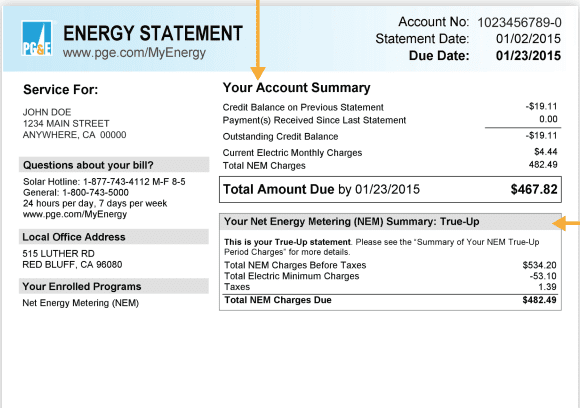
As a solar owner, you are not required to pay your true-up bill on a monthly basis. However, it is important that you check each month to ensure your solar generation is optimum. When first going solar, it is common for users to overcompensate for their new system by using more power than normal. This account information is available to you each month. Meaning, that estimating your annual bill based on your charges to date should be easy. If you have a negative balance, that means you have been awarded a credit to apply to the next month. You may not use net energy credits to pay for “non-energy” charges, or any other account other than your NEM billing agreement.
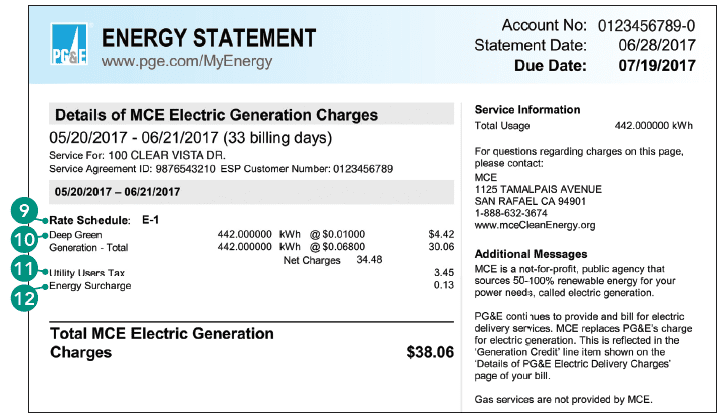
Your annual bill is simplified and displays a sum of all of the monthly credits & charges. It shows a total amount due over what is known as a relevant period (the last 12 months). If the calculation states that you owe money, that amount is due by the date stated. An awarded credit is not carried over to the next month because it is outside that relevant period. However, you are compensated for the energy you produced if you are a PG&E true-up customer through the Net Surplus Compensation program. “California State Assembly Bill 920 authorized payments to be made to NEM customers who generate more electricity than they use over their 12-month billing cycle” (PG&E.com).
You should monitor your usage when the date of your True-Up bill approaches for a number of reasons. Firstly, you want to make sure that you prepare to make any payments you may owe. Additionally, you may choose to adjust how much power you use to accommodate your outgoing balance. You are only awarded .03-.05 cents per kW/h by PG&E if you chose to redeem your credit during this time. We recommend our customers just live more comfortably in the last month or two of their billing cycle to adjust the balance to zero. Whatever you choose, we hope that all our customers are satisfied with their year-end true-up bill balance.
Tips for Managing and Reducing Costs on Your Solar True-Up Bill
Going solar doesn’t necessarily offset all of your energy costs. It’s important to know what helps reduce the cost of your bill and what doesn’t. Managing and reducing costs on your solar true-up bill can help you maximize the financial benefits of your solar investment. Here are some practical tips to help you keep your true-up bill as low as possible:
Understanding Your Energy Usage
You may not realize how much energy your appliances require and it could be increasing your total energy usage. Appliances like EV chargers, AC, or dishwashers can cause this.
Understand that there are times in the day where peak vs. off-peak rates differ, so you may want to check when you are using most of your electricity and limit energy consumption during those hours.
Energy Efficiency
If the bill is higher than you expect, look into insulation/ventilation especially if you are using an AC or heating system. Leaks in your home can cause your heating and cooling systems to do more work and consume more energy to maintain desired temperatures.
Monitoring
Monitor your system regularly using manufacturers apps to stay on top of how much electricity your system is generating. Be aware of how much energy you use per month and compare previous months. Your utility should provide information on your production and usage, which will help you understand the difference between the two..
Maintenance
Dirty panels can reduce the electricity generated by your solar by 30% or more. Ensure that animals or pests are not making their home below or near your solar panels, as that could cause performance issues. At Solar Negotiators, we offer solar panel maintenance as part of our solar services. If you are looking for someone to inspect or perform regular maintenance on your solar panels, please reach out and we’ll have a solar expert scheduled in no time.
Non-Export Add Ons
If you are still under NEM 2.0, you may be eligible to get a non-export add on to your solar system without triggering NEM 3.0. Just like the name implies, you won’t be able to export this energy back to the power grid. However, the benefit is that you’ll be able to store solar energy for later use using a solar battery, or use the energy generated on demand to power your appliances.
Conclusion
You now have the information to make sure you are awarded credit by the time your TrueUp bill comes around. If you are happy with your bill and can testify to our services here at Solar Negotiators, share your story on one of our review sites!
Tell us about your latest TrueUp Bill here —> wwww.solarnegotiators.com/reviews

Recent Posts
Solar Tariffs – Are They Here To Stay?
Solar Backup Solutions: How Do Solar Batteries Work?
When Is Solar Worth It
Reduce your reliance on the energy grid.
Get Solar In
Your Inbox

Refer friends and get paid in-app
The more referrals you bring in, the higher your earnings.
Earn $1,000 for each referral, and bonuses of up to $1,500 once you hit your 10th referral.

